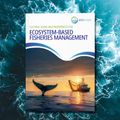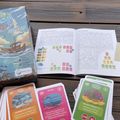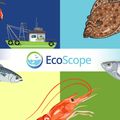EcoScope Contributes to UBC’s new Ecopath textbook
EU-funded EcoScope project researchers Villy Christensen and Carl Waters of the University of British Columbia’s Institute for the Oceans and Fisheries recently released a new textbook on Ecopath with Ecosim (EwE), titled Ecosystem Modelling with EwE, four chapters of which were written specifically for EcoScope.
“This comprehensive textbook delves deep into the what and why of the Ecopath with Ecosim (EwE) software suite – a powerful tool designed for analyzing food webs and assessing trade-offs in the impact of fisheries and environmental changes on aquatic ecosystems,” the UBC publishing house said about the book. “In the ever-evolving field of ecological modelling, Ecosystem modelling with EwE stands out as a seminal text, essential for students, researchers, and professionals keen on mastering ecosystem-based management tools,” they added.
The four EcoScope chapters in the book are, “Fishing policy exploration” (chapter 45), “Risk-averse portfolio utility” chapter 46), and thereafter a chapter demonstrating implementation titled “Tutorial: Policy exploration procedure”. The fourth chapter was in the accompanying User Guide for Ecopath with Ecosim (EwE), and also titled “Fishing policy exploration”.
At the end of each of these chapters, the authors put a dedication alongside the EcoScope logo, indicating that, “This chapter was developed for the EcoScope project to guide implementation of the EwE Policy Search for the project case studies.”
Chapter 45 in Ecosystem Modelling with EwE, “Fishing policy exploration”, begins with a notice that the interface for the policy exploration is described in the chapter of the same name in the User Guide for Ecopath with Ecosim (EwE).
The chapter presents the formal optimisation method implemented within Ecosim that can be used to search for fishing policies to maximise particular policy goals or “objective functions” for management.
“This method is an ‘open loop’ policy exploration simulation and optimisation that acknowledges that policy may be defined as an approach towards reaching a broadly defined goal, that fisheries policies are often implemented via quotas that are recalculated annually, and through regulation that affects fleet structure and deployment.”
The chapter details the pros and cons of two very different approaches implemented in the policy search to identify optimum levels of fishing efforts for multiple fleets so that each may exploit multiple species from an ecosystem. (1) The “sole owner” or societal approach aims to identify a single, overall performance measure for combined value from all fishing operations, then vary the by-fleet efforts so as to try and maximize this performance measure. (2) The
“multiple fishing rights” approach treats each fishing fleet – as well as non-consumptive stakeholder or user groups, if desired – as a separate economic industry with legal right or entitlement, then seeks a level for each fleet that optimises a fleet-specific performance criterion such as total profits or growth, until profitability (ratio of profits to income or cost) aligns with a reasonable level for economic industries in the economy as a whole.
Policy objectives factored into these approaches include: maximising fisheries rent (profits or net economic value), maximising social benefits (jobs), maximising mandated rebuilding of species, maximising biodiversity, and maximising ecosystem structure.
The policy exploration/optimisation method has two alternative objective functions, where by default the objective function is defined based on an evaluation of these five weighted policy objectives.
The second option implements a risk-averse utility measure that – instead of setting relative weights to different objectives – uses an alternative objective function invoking a balanced “investment portfolio” of fishing activities. This method is described in Chapter 46, “Risk-averse portfolio utility” and is activated by checking the Maximize portfolio utility option in EwE, as described in the User Guide for Ecopath with Ecosim (EwE)’s “Fishing policy exploration” chapter.





